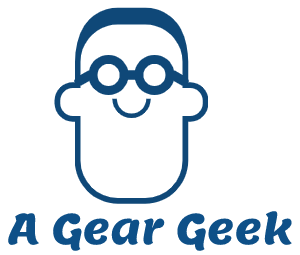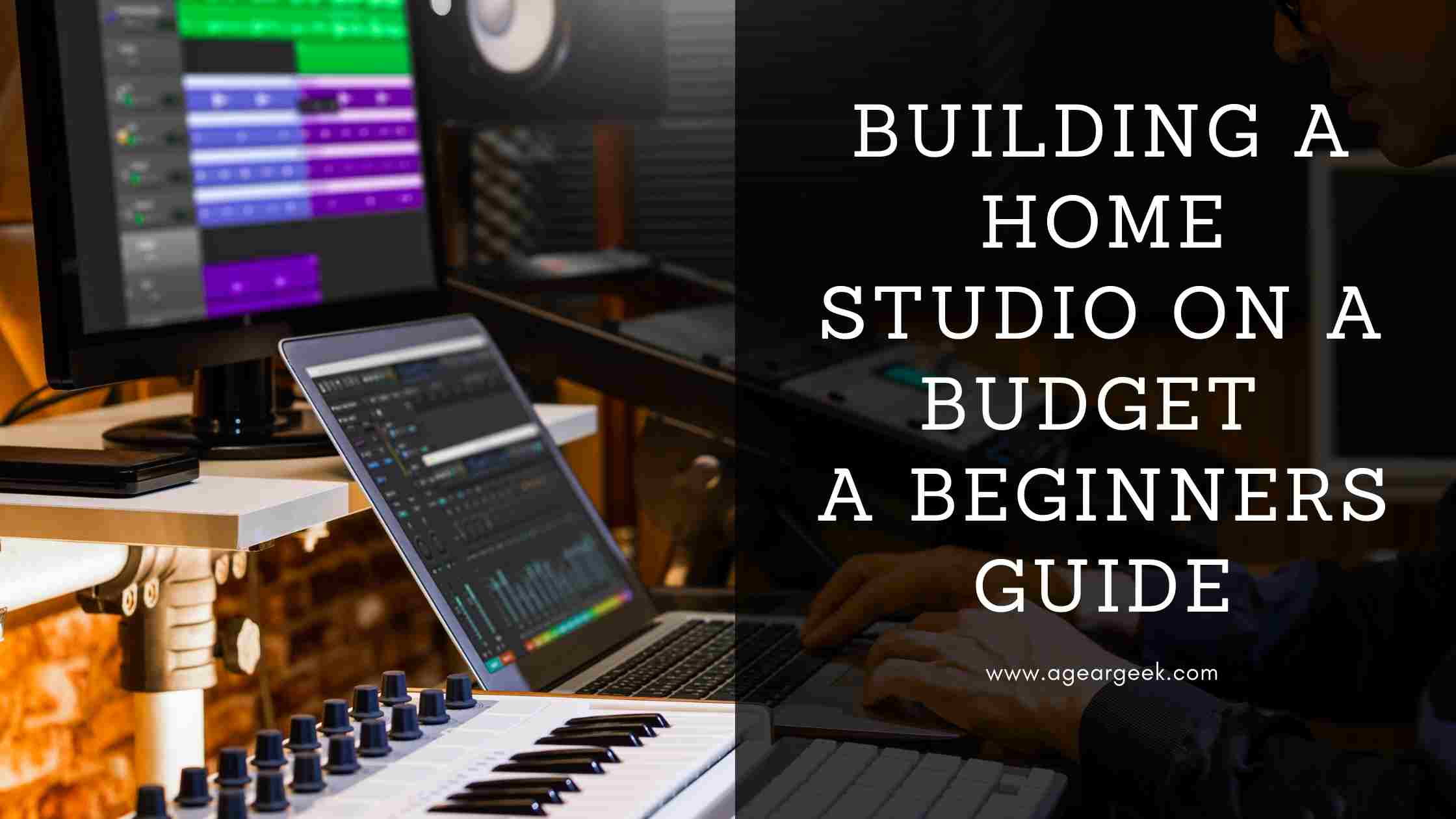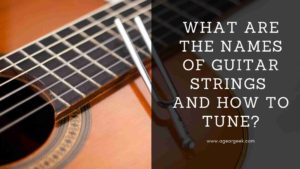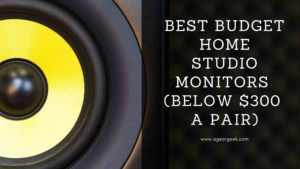Home studio on a budget? We have you covered. It is a great feeling to have a home studio and it provides you with limitless possibilities in your musical journey. But for a beginner when you are starting off setting up one, the cost you incur could be daunting. In this article, we will cover how you can start building a great home studio on a budget.
Disclosure: We’re an affiliate. We hope you love the products we recommend! This post contains affiliate links. If you use these links to buy the products, we may earn a commission from the qualified sales. These are at no additional cost to you. Thank you if you use our links, we really appreciate it!
What to Consider
When you are building a home studio on a budget, it does not mean that you use cheap quality equipment. The difference here is that you use quality products from well-known manufacturers but which might not have the high-end features. Honestly, what we will cover should be more than enough for a beginner and can also be used by a professional.
In fact, this is a good way to start. If you ask any music producer, they acquire the gadgets over a period of time and none of them started with the perfect studio.
Let’s get started.
How do the numbers stack?
We have done 2 builds for you with slightly different specs. We have considered that you will use your current laptop and use free DAWs which you can either download, get as a bundle with audio interfaces, or is preinstalled if you are a Mac user. The prices of the laptops are also given separately if needed.
Both the builds are comprehensive and you will not need to upgrade in a long time.
Build 1 – Below $ 1000
(Prices at the time of writing this article)
| Component | Equipment and Model | Price |
| Audio Interface | Presonus Audiobox USB 96 | 99 |
| DAW | Free Daw | 0 |
| Monitors | 3.5″ monitor Pair | 100 |
| Microphones | Shure SM 58 | 100 |
| Audio Technica AT 2020 | 100 | |
| Headphones | Samson SR850 | 42 |
| Audio Technica ATH M50x | 149 | |
| MIDI Controller | Akai MPK Mini MKII | 114 |
| Acoustics | Wall Panels (5 boards) | 147 |
| Bass Traps 1 unit | 130 | |
| Total | Total excluding Laptop | 981 |
| Laptop | Acer Aspire 5 A515 – 56T – 574 E | 699 |
Build 2 – Below $ 1500
(Prices at the time of writing this article)
| Component | Equipment | Price |
| Audio Interface | Scarlett 2i2 3rd Gen | 159 |
| DAW | Free Daw | 0 |
| Monitors | 5″ monitor Pair | 300 |
| Microphones | AKG D5S | 109 |
| MXL 770 | 109 | |
| Headphones | AKG K240 | 69 |
| Audio Technica ATH M50xBT | 179 | |
| MIDI Controller | Novation Launchkey Mini MkII | 109 |
| Acoustics | Wall Panels | 188 |
| Bass Traps x 2 | 260 | |
| Total | Total excluding Laptop | 1482 |
| Laptop | Asus VivoBook 15 X512DA | 749 |
Laptop
Though for the purpose of the builds we have assumed that your current laptop should suffice, if you need to get one then this section will help.
The first thing that you will need is a decent laptop or computer which will help you to run your music software. Most of the DAWs recommend a decent processor like an i5 for Intel or AMD Ryzen 5 line or above with at least 8 GB RAM.
Of course, if you are getting a superior processor with higher specs of RAM, the experience will be a lot better with smoother performance. This is specifically true when you want to run multiple plugins which might take a lot of the CPU bandwidth.
Lastly, you will need storage and the options are either HDD or SSD. HDD is cheaper and slower while SSD is faster and comparatively more expensive.
Generally, Windows laptops provide a better bang for the buck. If you already have an Apple Mac Book, then you have a head start with preinstalled DAW in it. If you need to purchase one, then a windows one will give you similar specs as Apple at a comparatively lower price.
Below are some of the options which provide an incredible value for money.
Acer Aspire 5 A515 – 56T – 574 E
No products found.
This delivers an amazing value at the price point at which this is offered. This laptop ticks all the right boxes for music production. It has an Intel i5 processor with 4 core, 8GB RAM, 512 GB Solid State Drive (SSD), and comes with USB type C connectivity for lightning-fast connectivity.
Asus VivoBook 15 X512DA
No products found.
This comes at a slight premium to the above model but with improved specs. This uses an AMD Ryzen 7 3700 U processor, 12 GB RAM, 512 GB SSD, and also comes with USB 3 type C connectivity.
Audio Interface
An audio interface is a piece of equipment that helps to convert the sound signals to be used in DAW and also for play back. The Audio interface converts the analog sound signals to a digital signature to be stored in your laptop and also converts the digital to analog for playback.
There are a few things that you need to know about Audio Interface – sampling rate and bit depth. For the sake of simplicity, a higher value of these 2 corresponds leads to better audio.
Of course, the more you cramp in an audio file, the larger it becomes. Nowadays most Audio Interfaces provide 24 bit and 96 kHz sampling rate (in fact sampling rates of 192 kHz are becoming more common). Most of these audio interfaces are brilliant.
Though most of the audio interfaces come with a Phantom Power (48V) option and a zero-latency headphone jack, but it is good to check the model you are choosing if it has one. Lastly, the interface should ideally have a Hi-Z input for recording electric guitars. You can get more information on Audio Interfaces in this article here.
Presonus Audioboox 96 USB
No products found.
This is perhaps the cheapest studio-grade audio interface in the market today. It has 2 ins and 2 out and comes with a zero-latency headphone jack. The input channels have auto Hi Z switching. It has a bit depth and a sampling rate of 24-bit 96 kHz which is more than enough.
As an added feature this interface also has MIDI connectivity which is generally not found in such entry levels. The Audio Interface is powered by a USB 2 type B connection. The Audiobox 96 USB comes with PreSonus’ Studio One 3 Artist DAW software and is compatible with both Mac and Windows.
Focusrite Scarlett 2i2 3rd Gen
No products found.
This is perhaps the most common Audio Interface used for home studios. The reason could be that Focusrite is able to achieve a great balance between quality and the price at which this interface is offered.
The Scarlett 2i2 is a 2 in/ 2 out interface with a 24 bit – 192 kHz sampling rate. The 3rd gen models come with Focusrite’s AIR mode in the preamps. This enhances the mid-high frequency like Focusrite’s original ISA preamps at the AIR studios. This also comes with a Phantom Power option, Zero Latency Headphone-out, and a Hi-Z mode. This is powered by USB 2.
This comes in a bundle with Pro Tools or Ableton Live Lite DAW.
Digital Audio Workstation
Digital Audio Workstations or DAW is the music software through which you will run your music and save it on your hard drive. Through these DAWs, you will be able to layer different tracks and bring different instruments or vocals in to create your music. You can also bring in plugins for virtual effects and instruments.
There is no hard and fast rule on which DAW is the best. One thing you should keep in your mind is that a DAW should be able to simplify things for you rather than complicating them.
Free DAWs
There are a bunch of Free DAWs which you may want to try out first before getting into more professional ones. Below are some recommendations.
Garageband
If you are a MacBook owner you will have Garageband already preinstalled in your system. This is a beginner’s DAW that helps you to learn how to use the basic steps and then you can upgrade to Logic Pro.
LMMS
This is an open sourced DAW, which means there are many people who are involved in developing this and you can also play your part here to. This DAW can be used in any operating system and uses minimum CPU functions.
Paid DAWs
FL Studio
No products found.
This is one of the go-to DAWs. They have various options but when you buy any of their packages, you get lifetime updates. There are plenty of Youtube videos and tutorials on FL studio, so you will not be left to learn the ropes alone. The amount of material out on this is simply staggering showing the number of professional music makers using this. You also get this in a bundled deal with some Audio Interfaces.
Ableton Live
No products found.
This is another great DAW to go for. It is very intuitive and easy to access instruments and effects in the same interface. Again this DAW has been in the market for a very long time and there are countless numbers of videos and tutorials on how to use this DAW.
The Ableton site itself has good resources including the blog section. It has various packages and you can start with the basic one and slowly climb up the curve.
Some of the audio interfaces offer the basic version of this DAW as a bundle. I would suggest going that route. Otherwise, you can also check out the link in this section.
Microphones
You will definitely need a few microphones for your budget home studio. Before we get into which microphone is better, it is good to understand the types of microphones.
Broadly there are 3 categories of microphones – Dynamic, Condenser, and Ribbon. Dynamic microphones are sturdier and less sensitive than condenser microphones. These are great for loud sounds and handles them well.
Condenser microphones are more sensitive than dynamic microphones. Among the condenser microphones, you have a Large Diaphragm Condenser which is great for vocals capturing the lows and the minute nuances. The Small Diaphragm Condensers are great for brighter instruments like cymbals and percussion or acoustic guitar.
Lastly, the Ribbon microphones are the most sensitive and are used to capture vintage style warm vocals. These are the most expensive microphones. Important to know that condenser microphones will need Phantom Power (48V) and Ribbon Microphones need a paired amp to power the microphone.
Polar Patterns
Microphones also come with different polar patterns. Polar patterns are the inherent directionality of the microphones. The most commonly used Polar Pattern is the Cardioid Pattern. In this mode, the signal from the front of the microphone is captured while from the back and sides are rejected. The figure of 8 pattern captures frequencies from both the front and back but rejects anything which comes from the sides. Last you have an omnidirectional pattern that captures sound from around the room without any rejection.
You can get more detailed information on microphones in this article here.
For the purpose of your budget home studio, you are best to have a Cardioid or a Super Cardioid pattern Condenser or Dynamic Microphones. Ribbon microphones are very expensive and delicate for home use. Below are some great options around USD 100 at the time of writing this article.
Shure SM58 dynamic vocal microphone and the Shure SM587 dynamic microphone are great choices. AKG D5 S is also a great option for a dynamic vocal microphone with super-cardioid pattern.
No products found.
Among Condenser Microphones MXL 770 and Audio Technica AT 2020 are great options.
No products found.
Studio Monitors
Studio Monitors are the best friends of a recording artist. These monitors differ from the regular home hi-fi systems which are known to color the original sound. Normal home theatre systems or computer speakers boost certain frequencies in an attempt to make them sound more appealing to the human ear.
If you mix your production on these monitors, you will not get a true understanding of the original sound. This as a result will lead to a very poor mix which will not sound good on any audio system or headphone.
We need studio monitors as they provide flat frequency response and transparent and accurate reproduction of the original sound. These are your ears for recording and mixing. If something is not right, you should be able to catch it and correct it in the mix.
The monitors which we use in a home studio are active 2 way near field monitors. Fortunately, we do not have to break the bank to get some good monitors as there are some really good options available in the market today.
Read here for more information on budget home Studio Monitors.
For these monitors, you can either go for the smaller 3.5’’ woofers or the most commonly used for home studio with 5” woofer models.
Mackie CR 3
No products found.
This Monitor is perhaps the most common and has been on the budget home studio desk of most beginners. These come at a fantastic price compared to the value they bring. These are not marketed as studio monitors but are marketed as multimedia speakers, but in reality, these provide a very accurate response on which you can record and mix.
Presonus Eris 3.5
No products found.
The Presonus Eris 3.5 delivers studio-quality sound in a small package. These provide smooth and accurate sound which you can trust. The silk dome tweeter produces a wide dispersion pattern, creating a larger listening area. This enables you to get an accurate idea of the sound even moving around the room. The woofer is 3.5” producing very clean audio.
Presonus E5 XT
No products found.
If you are going for the larger size of monitors, then this is perfect. These budget monitors are actually created for home studio, meaning that they are in reality created for rooms that are not expected to have high-quality acoustic treatments done.
The E5 XT comes with a 5.25” woofer and 1” silk dome tweeter with waveguide sound dispersion. These monitors are front-ported to avoid bass build up in cases where the monitors are placed too close to the walls. They also come with a bunch of switches in the back to customize the frequency for your environment. Great looking monitors with stunning sound.
Kali Audio LP 6
No products found.
The Kali Audio LP 6 is perhaps the best monitor among the 5” to 6” category. These monitors in addition to being very accurate and transparent sound-producing ones also build in a massive 112 dB SPL. It provides a specific listening distance of 2.2 M to receive the 85 dB SPL with additional headroom for another 20 dB. These monitors can be loud. Kali’s 3D waveguide reduces unwanted reflections and provides a clear sound in the stereo field.
Headphones
A home studio setup whether budget or not is never complete without headphones. This is especially true for home studios as you will work odd hours and speaker volumes can become a hindrance. Here the headphones come in very handy. You can use headphones for your recording sessions, or mixing or playing your guitar or instrument in silence mode.
Closed Back and Open Back Headphones
Headphones can be primarily of two types – Closed Back and Open back headphones. Closed-back headphones are ones where the ear cup is completely sealed, stopping any air or sound to move out of the cup. These headphones are great for isolation and are great in active noise cancellations.
On the other hand, we have the Open back headphones which are not completely sealed. As a result air and sound both can move in and out of the ear cups. These headphones do not provide good isolation as a closed-back, but these sound a lot better. For mixing purposes Open back headphones are preferred hands down.
The sound of an Open Back headphone is expansive and has more dimension to it than a closed back. It sounds more natural and you can feel the instruments in the stereo field and has a lot more depth. It allows you to have a more spatial experience.
But open-back headphones, apart from mixing or private music listening, it is normally not used outside or even during recording. The reason being that the open-back nature of the headphones leaks sound. If you are using this in an office or while traveling, your immediate neighbors will be able to hear you. If you are using this as a monitoring headphone while recording, some of the sounds from the headphone can bleed into your recording.
You can learn more about open backs and closed back headphones here.
So as long as you are using open backs for your home studio purposes, you cannot go wrong. Given are some good choices for both closed back and open back which are inexpensive but at the same time provide great sound.
AKG K240 Studio Professional Headphones
No products found.
The K240 has been around for decades and it is a staple for any studio to have a few of these. These are considered semi open-back headphones but does provide all the sonic benefits of an open back. It has a detachable cable which you can change in case of wear and tear and not the entire set.
It is a classic low impedance headphone for which you will not require a headphone amp to power. These produce some mind-blowing accurate and transparent sound, which at this price point is an absolute buy. No brainer.
Samson SR 850
No products found.
The Samson SR 850 is another brilliant choice for an open back headphone. This rather inexpensive headphone provides a listening experience similar to one’s lot more expensive. Quite handy to be used without any amp requirement as this is a low impedance headphone.
Audio Technica ATH M50x
No products found.
The audio technical ATH M50x is a closed-back headphone and does provide a great listening experience. It comes at a price that does not break the bank and that’s why this specific model has been bestsellers for years. It has a detachable cable which helps to change the cable in case of wear and tear and not change the complete set. There is a blue tooth version now available ATH M50x BT
Acoustic Treatments
If the objective is to have a good sounding recording and mix, then getting some acoustic treatment done is a necessity. A small amount of acoustic treatments can help to improve the sound drastically.
There are 2 things which you need to know – first reflection points and the bass traps. Getting small treatment done on these two points can help to improve your sounds by tons.
First Reflection Points
No products found.
First reflection points are the areas on the walls where the sound from your monitors bounces off. It is easy to identify them.
Position yourself at your studio console chair and ask for a second help to move a mirror on the side walls at the same height as that of the monitors. Where you first see the reflection of the woofer on the mirror on the wall from your seating position, that is the first reflection point.
Go further down to capture the first reflection of the other monitor on the same wall. These are 2 points on your wall where the sound is going to hit first. Do the same for the other wall as well.
Once you have identified these points, put acoustic panels to stop the sound from bouncing. The same applies to the ceiling. Getting some acoustic panels above your seating position on the ceiling can help immensely. Lastly for the floor, using a carpet can do the job for you.
Bass Traps
No products found.
The corners of the rooms are the places where Bass builds up. Covering these corners will thick acoustic treatments help to improve the sound drastically.
Both of these treatments do not cost a fortune and by spending a few hundred dollars you can make a real difference to the sound.
MIDI Keyboard
If you are building a home studio then you will definitely need a MIDI controller. MIDI stands for Musical Instrument Digital Interface and it looks like a keyboard and is connected to your computer.
Unlike a normal keyboard, a MIDI keyboard does not have any sound of its own but is generated by the virtual instrument plugins used in your computer. With this, you can virtually play or insert any instrument into your recording.
These come in a number of keys 25, 49, 61, 88, etc however for a beginner’s budget home studio you can start with 25 keys.
The Akai MPK Mini MKII or the Novation Launchkey Mini MkII are great options at 25 keys.
No products found.
Summing Up
Building a budget home studio from the scratch is very exciting. We hope the above details help you to choose the equipment wisely. You should always remember that no studio at any point in time is perfect, there is always a desire to upgrade and improve. All musicians do this over a period of time. The important part is to enjoy the journey.
Last update on 2024-05-03 / Affiliate links / Images from Amazon Product Advertising API






Pingback: What equipment do singers & songwriters need? - A Gear Geek